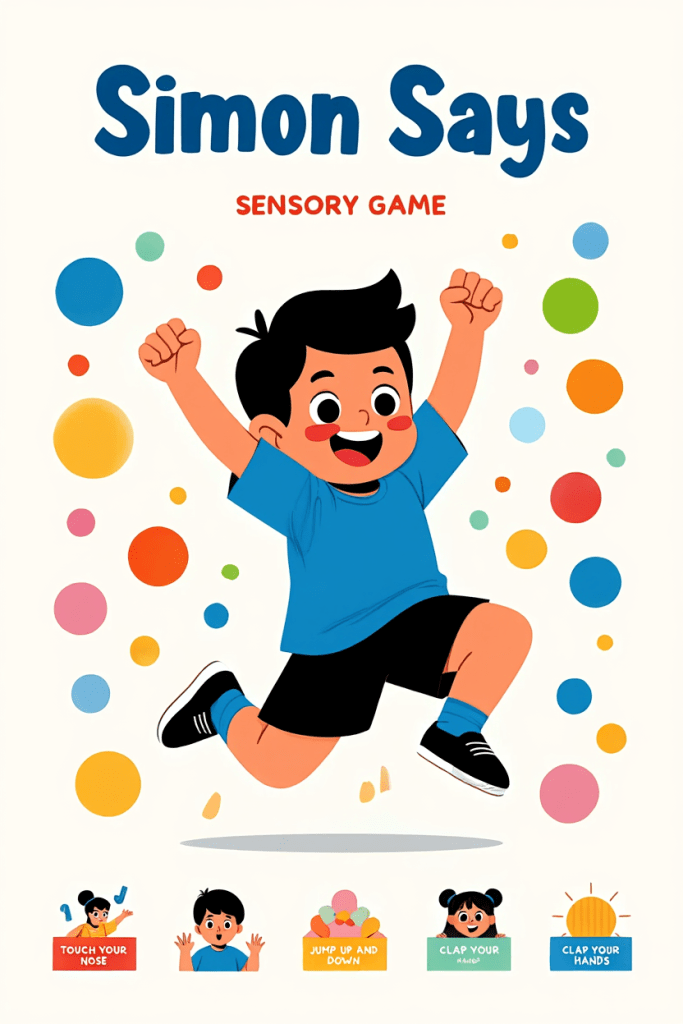
Sensory Simon Says Game for SEN Learners
Sensory Says: A Multi-Sensory Twist on Simon Says
Sensory Says is a fresh, neurodiversity-affirming take on the classic game Simon Says. Designed to engage children through a full range of sensory experiences, it supports regulation, attention, body awareness, and emotional literacy, while still being playful and accessible. Whether used at home, in classrooms, or in therapy settings, this inclusive game can be adapted for all ages and abilities.
How to Play Sensory Simon Says
The structure mirrors that of Simon Says: one person is the leader and gives instructions. If the leader begins the command with “Sensory says…”, the children must follow it. If the leader leaves out “Sensory says”, the children should freeze or remain still.
Unlike the original, however, the focus here is on using the 5 main senses, not just physical movement. The actions should involve touch, sound, sight, smell, movement, or emotion. The aim is to build children’s sensory awareness and language, while offering calming or alerting input through playful engagement.
Sensory-Based Command Examples
Visual prompts might include:
“Sensory says, look for something red in the room.”
“Sensory says, follow my finger with your eyes.”
These develop scanning skills, visual attention, and colour recognition.
Auditory prompts could be:
“Sensory says, clap when you hear this bell.”
“Sensory says, close your eyes and listen to a sound.”
This helps with sound discrimination and auditory processing.
Tactile prompts may be:
“Sensory says, rub your hands on something soft.”
“Sensory says, press your palms together as hard as you can.”
These offer grounding touch input that supports regulation.
Smell-based cues might include:
“Sensory says, sniff the lavender pouch.”
“Sensory says, take a deep breath and smell the lemon.”
Use these sparingly and only with known-safe scents. They’re especially useful during quiet or cool-down times.
Taste cues, while optional and context-specific, could include:
“Sensory says, lick the sour sweet and show me your face!”
“Sensory says, take a bite of something crunchy.”
These work well during food-based sensory exploration or cooking lessons.
Movement and proprioception prompts are great for energising or calming:
“Sensory says, push against the wall with both hands.”
“Sensory says, jump five times on the spot like a kangaroo.”
These support body awareness and heavy work regulation.
Emotion-based prompts might include:
“Sensory says, show me your happy face.”
“Sensory says, give yourself a big hug.”
This encourages emotional expression and interoceptive awareness.
Download over 100 Sensory Simon Says Prompts in our Free PDF
Variations and Adaptations
For children with sensory processing differences or communication needs, the game can be easily adjusted.
In one-to-one sessions, remove the trick element and allow the child to engage with every prompt freely. This makes the game more therapeutic and less performance-driven.
In small groups, visual supports are key. Use picture cards, Makaton signs, or coloured symbols alongside verbal instructions. Keep commands predictable by repeating one type for a few turns before changing modality. For example, you might begin with three tactile commands before introducing a movement one.
For whole-class play, simplify instructions to one-step actions and provide a clear visual “pause” card when the leader doesn’t say “Sensory says”. Allow plenty of time for processing and encourage peer modelling or adult mirroring to scaffold understanding.
Letting children lead the game themselves can also be powerful. Create a sensory command basket with action cards sorted by sense. Children can take turns picking and reading out the cards. This builds autonomy, literacy, and confidence, and can help children communicate the types of sensory input they enjoy or need.
Educational Benefits
Sensory Says strengthens a wide range of developmental skills:
- It builds sensory language, helping children describe and explore how things look, feel, sound, and smell.
- It develops self-regulation by exposing children to calming or alerting inputs in a controlled way.
- It improves listening, attention, and working memory, especially when children must pause and wait for specific words.
- It supports gross and fine motor skills, depending on the nature of the prompt.
- It encourages children to name and act out emotions, which is key for emotional literacy and social communication.
For children who struggle with body awareness, sensory processing, or emotional regulation, this game can be a gentle, playful way to practise those skills without pressure.
Resources and Equipment
You can play Sensory Says with no equipment at all, using only body-based actions. However, for more variety, consider setting up a small sensory box with:
- Soft or textured fabrics (e.g., fleece, sequins)
- Lavender bags, citrus peel, or scent jars
- Shakers, bells, or chime bars
- Mirrors or laminated emotion cards
- Beanbags or small weights
- Wall charts showing movement cues
- Printed action cards sorted by sensory system
Keep the materials accessible, age-appropriate, and safely managed, especially if children are likely to mouth objects or have sensory aversions.
Ending the Game
To bring the game to a close and promote calm, use a short sensory cool-down sequence:
“Sensory says, sit quietly and listen to the sound of the bell.”
“Sensory says, close your eyes and take a deep breath.”
“Sensory says, give yourself a little round of applause.”
This helps children transition out of the game and return to a more structured activity or lesson.
Sensory Says is more than just a fun break from routine, it’s a tool for connection, co-regulation, and communication. Whether you’re a parent playing at home, a teacher leading group time, or a therapist supporting sensory exploration, this game can be shaped to suit your needs and the preferences of the children you support.

Related
Discover more from Special Education and Inclusive Learning
Subscribe to get the latest posts sent to your email.
Source link



